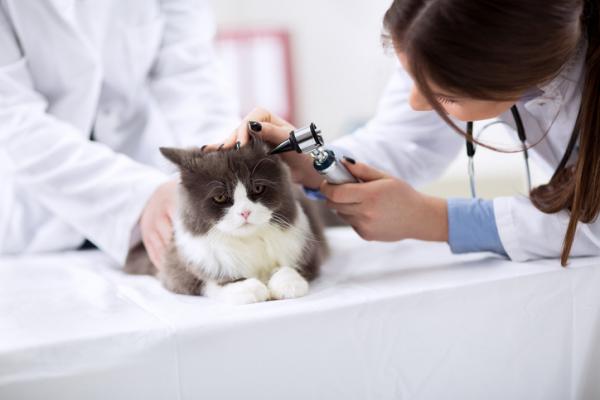Horner syndrome in cats – Causes and treatment

El Horner syndrome in cats consists of a set of symptoms that will affect the nervous system, specifically we can see their effects on the eye. This alteration can appear in cats of all ages.
In this article we will explain how we can recognize the Horner and what are the most common causes that can produce it Our veterinarian, after the examination of our feline, will be in charge of reaching a diagnosis as well as proposing the most appropriate treatment.
What is Horner syndrome in cats?
It is difficult to explain the mechanisms that lead to the appearance of a Horner syndrome. Broadly speaking we can say that there is a communication error in the nervous system that manifests with eye problems. Can be uni or bilateral, according to affect one eye or both. This failure has different causes and produces easily recognizable symptomatology.
Symptoms of Horner syndrome in cats
The clinical picture of the Horner is characteristic and we can suspect that our cat is suffering from it if we observe signs such as the following:
- Protrusion of the nictitating membrane or third eyelid: cats have this membrane that in this and other conditions extends over the eye to protect it. We will observe it perfectly as a white sheet that prolapses, occupying a good part of the eye.
- Miosis: which is defined as the fixed appearance of the pupil, which is permanently contracted.
- Eyelid ptosis: consisting of the slight fall of the upper eyelid over the eye.
- Enophthalmia: the eye seems smaller in size, it is as retracted in its basin.
Any of these symptoms is reason for veterinary consultation.

Causes of Horner syndrome in cats
It must be said that, sometimes, the cause that has triggered the syndrome is not determined. It is said that, in those cases, the origin is idiopathic. Other times we do conclude that this may be caused by a Trauma, which includes from outrages to falls from considerable heights, but also damages caused by bites such as those that can occur in a fight or in the attack of other animals.
Another cause of Horner syndrome is the otitis media or internal, that is, when there is an inflammation of the ear at its deepest levels, which ends up producing damage at the nervous level. Intoxications, infections and tumors They could also be responsible for Horner’s syndrome.
Diagnosis of Horner syndrome in cats
First of all the veterinarian will ask us about the circumstances of our cat to know if it has suffered an accident or we suspect it, if it has been sick or receiving any treatment, etc. The symptoms of the Horner are unmistakable, that is why it is more about reaching the cause behind its appearance.
To achieve this, the veterinarian can resort to different tests, among which are the blood tests, The radiographs, The magnetic resonance or TAC, that allow us to obtain information about the area at all levels. Of course, you should not miss a neurological, ocular and otic exam. If we establish the cause we can treat the origin of the problem.
Treatment of Horner syndrome in cats
The typical symptomatology of the Horner can send in a matter of weeks but the veterinarian will guide treatment for the cause that is identified. Thus, if our cat has suffered an accident or an attack we must assess whether it suffers other injuries, such as fractures. In these cases, they are usually needed analgesics, anti-inflammatory and even antibiotics.
If we are facing otitis, it is necessary to find out the cause to be able to formulate an adequate drug. Sometimes you will need anesthesia to be able to examine the ear and clean it in depth. Tumors can be treated but will have a guarded prognosis.

This article is merely informative, in .com we do not have the faculty to prescribe veterinary treatments or make any kind of diagnosis. We invite you to take your pet to the veterinarian in case of any type of condition or discomfort.
If you want to read more articles similar to Horner syndrome in cats – Causes and treatment, we recommend that you enter in our section of neurological diseases.


